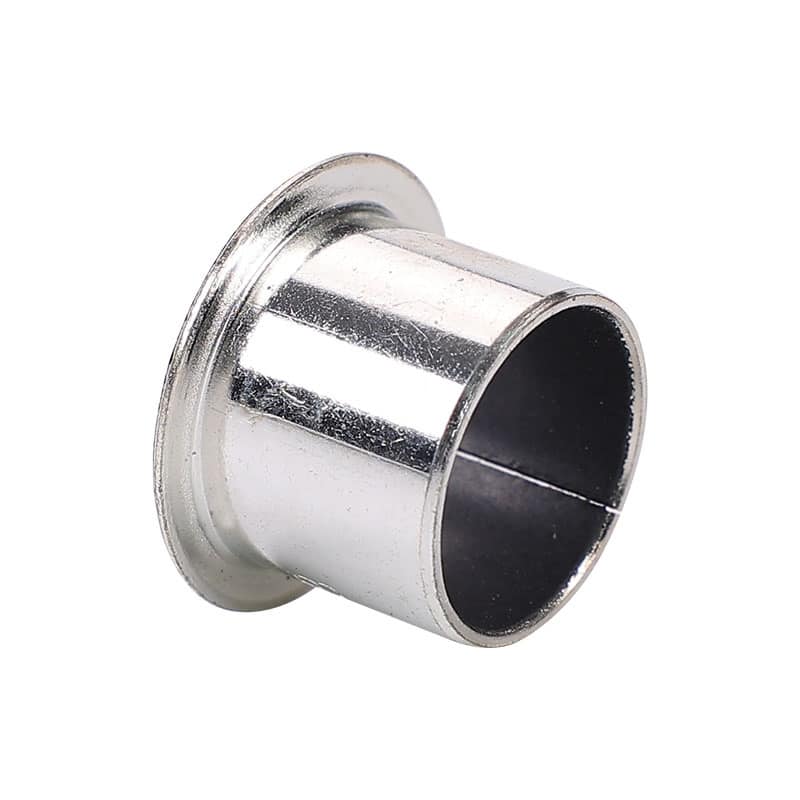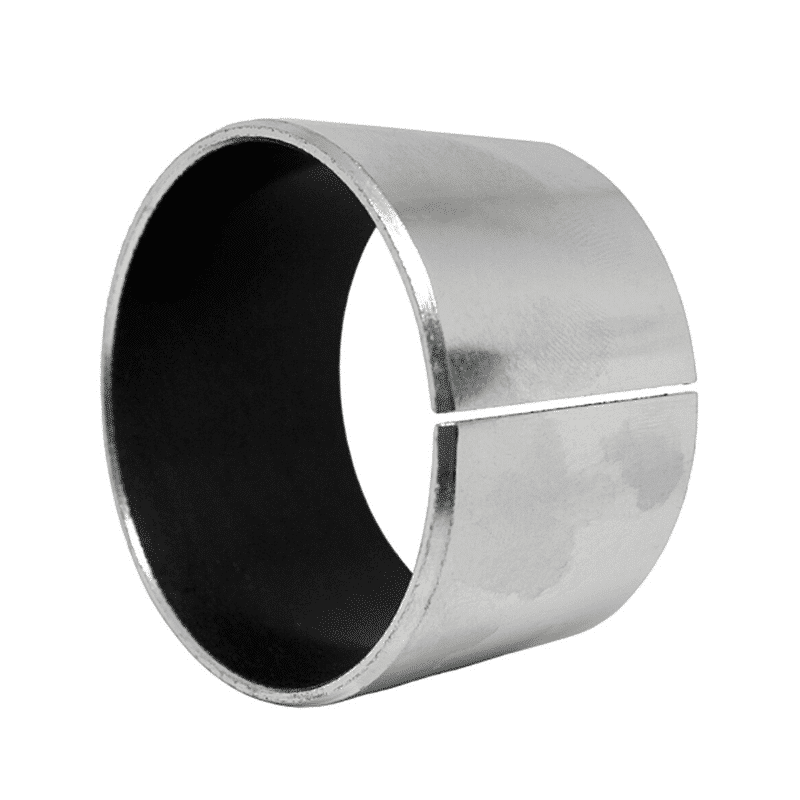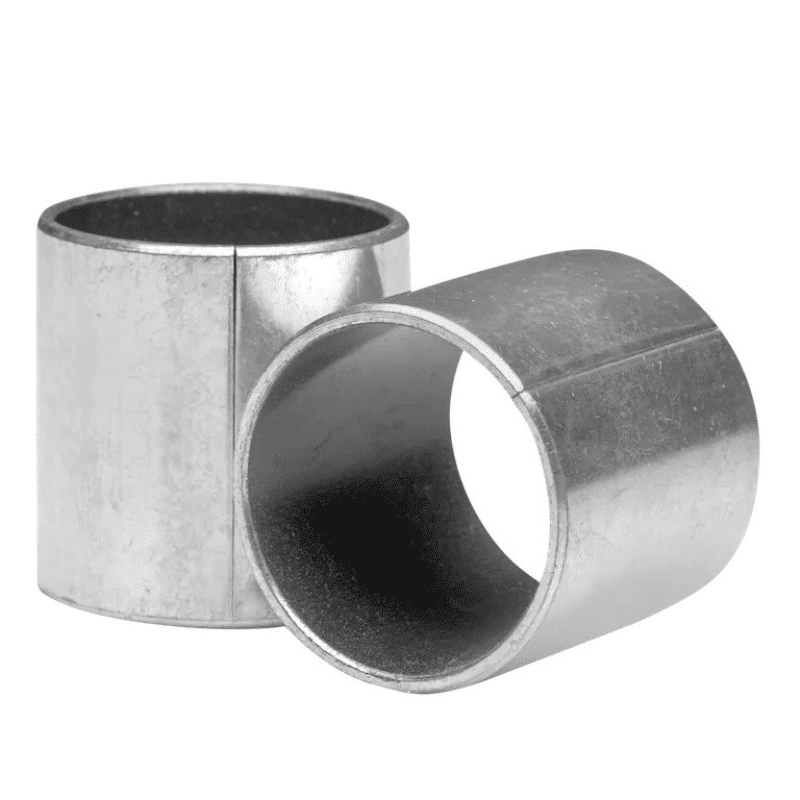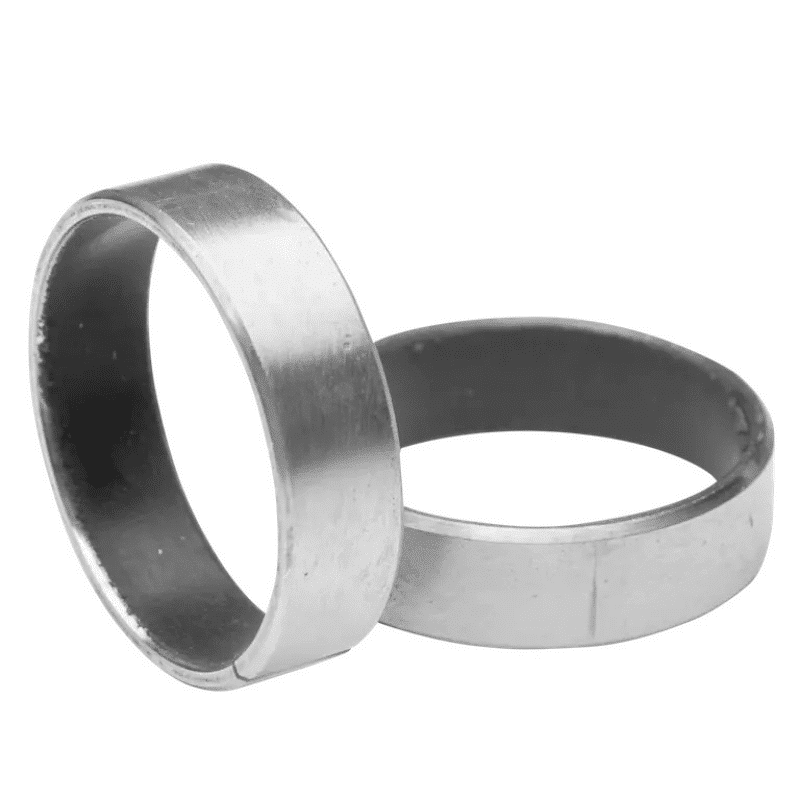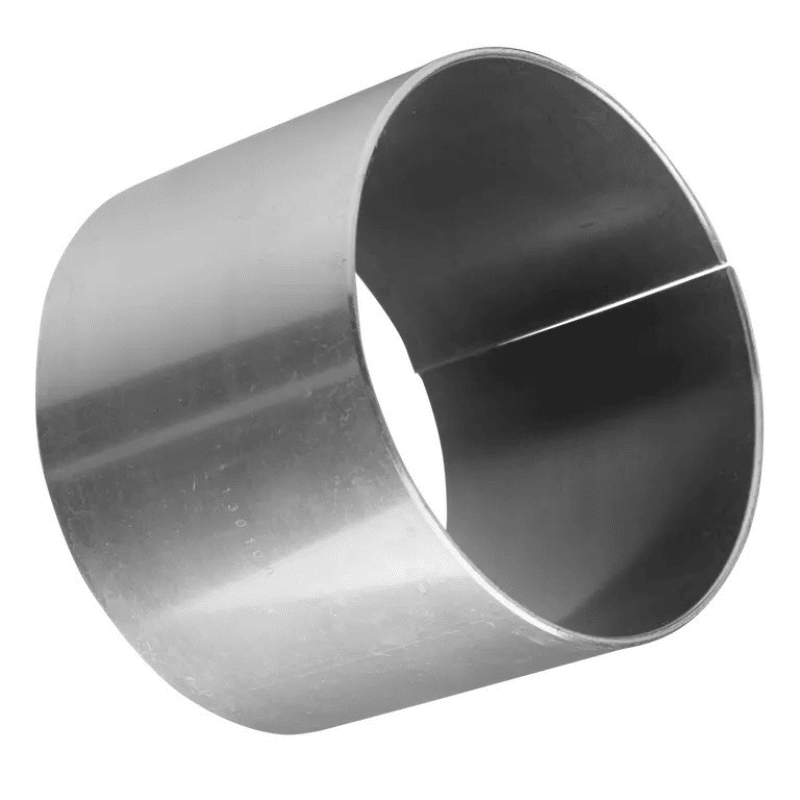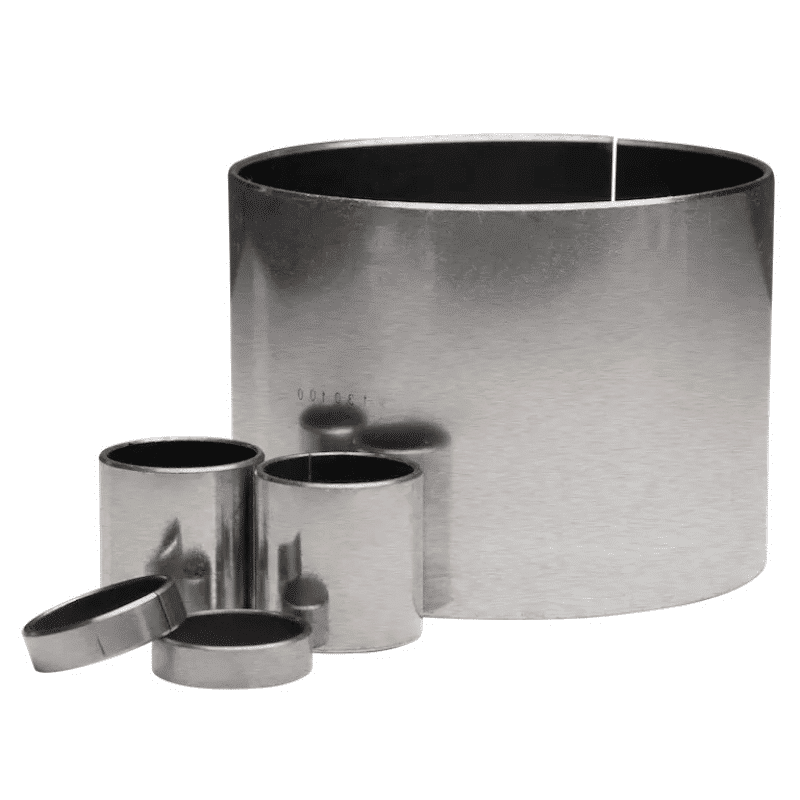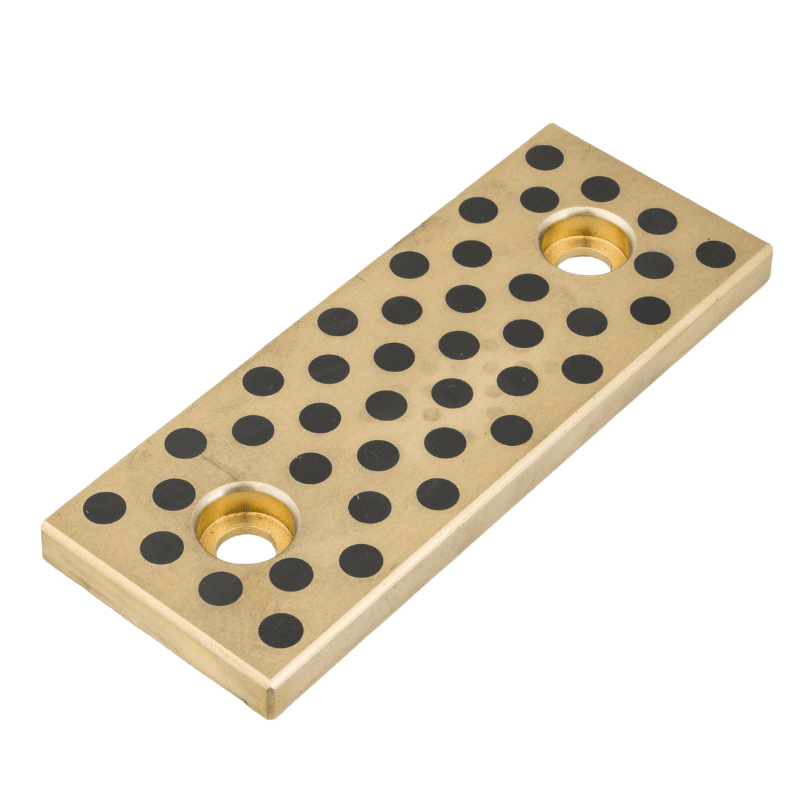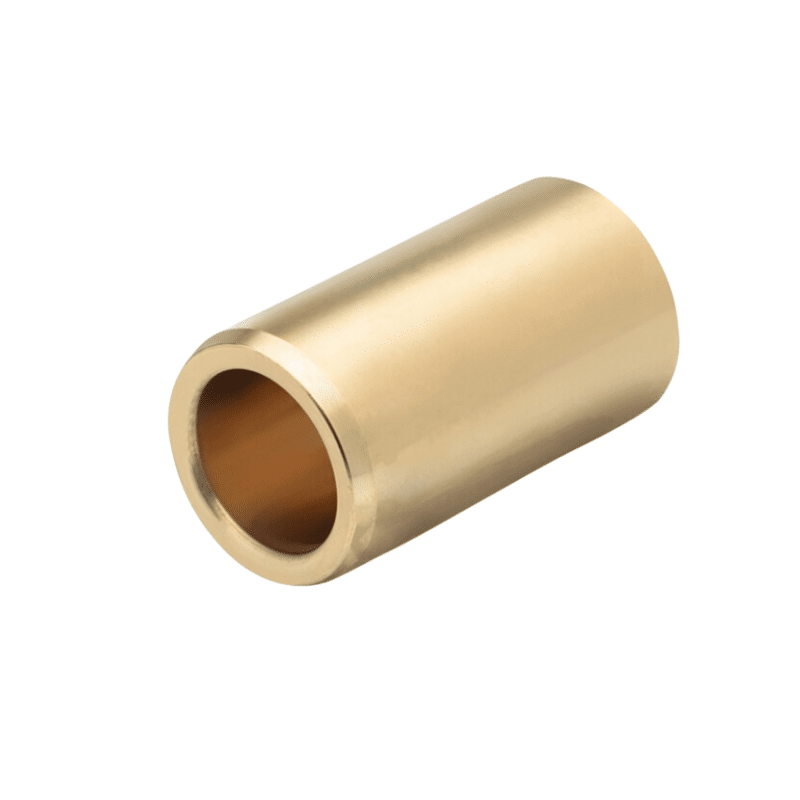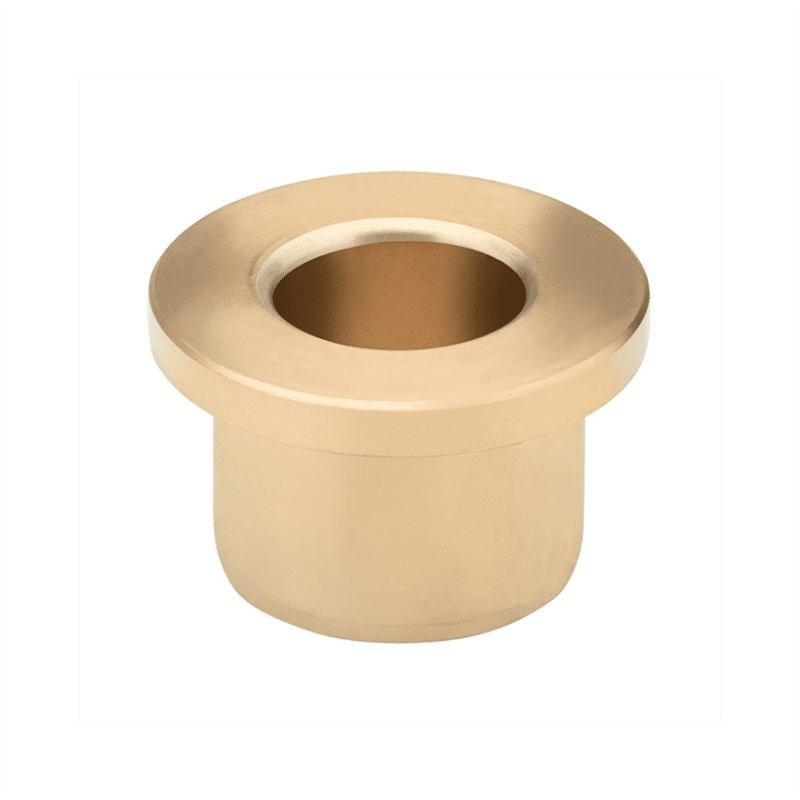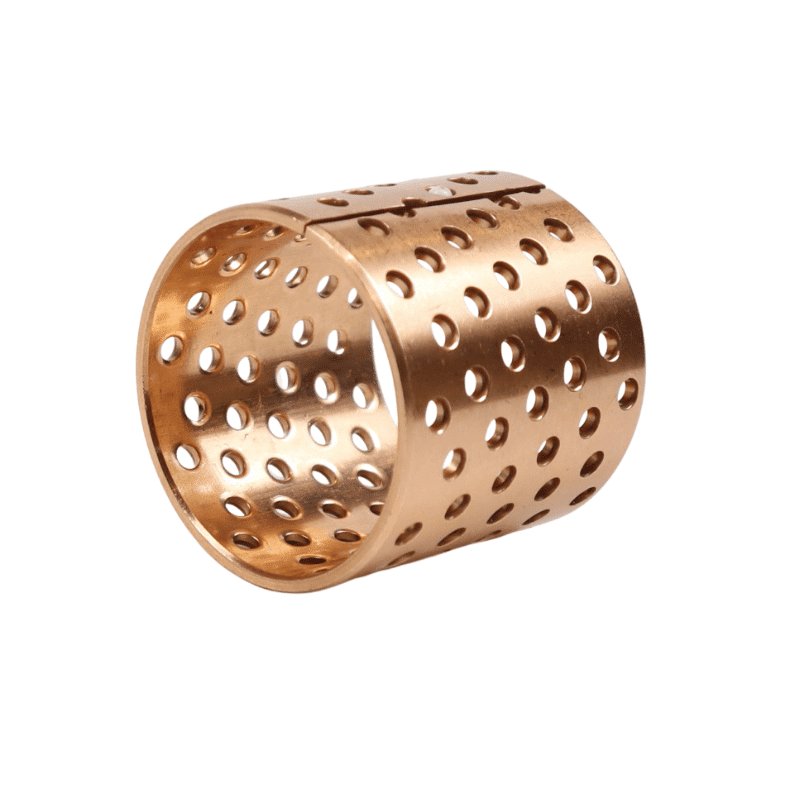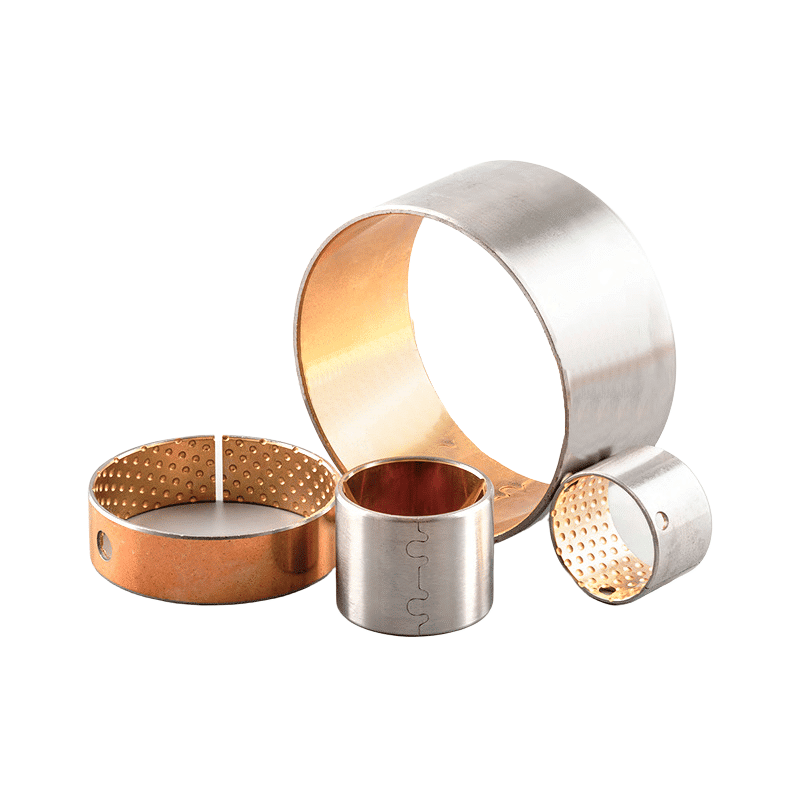Polytetrafluoroethylene sleeve bushing
Polytetrafluoroethylene sleeve bushing
Say goodbye to the hassle of frequent lubrication maintenance. Our self-lubricating technology ensures smooth operation and reduces wear and tear, extending the lifespan of your equipment. Experience uninterrupted productivity and cost savings as you bid farewell to the need for messy lubricants and time-consuming upkeep.
Manufacturing on Demand, alternative solutions
Polytetrafluoroethylene sleeve bushing
Polytetrafluoroethylene sleeve bushing Structure
After the rolling process is completed, PTFE mixtures are filled in interstice of the bronze layer. Under normal operation, Part of the PTFE mixture on the top layer will be removed and transferred to the mating surface, forming a physically lubricating film, which will reduce the friction cone. and protect the mating shaft.
2 Porous Bronze layer;
The layer provides bonded strength of Self-Lub. Layer.
3 Steel Backing
The layer provides load & thermal conductivity
4 Copper / Tin layer
Custom Parts Services and Prototyping!
Leaded, Phosphor And Aluminium Bronze Bearing, Search Our Material Alloy
The Emergence of Polytetrafluoroethylene Sleeve BushingsAlternative: A Shift in Bearing Technology
Sleeve bushing, High-Quality sleeve Polytetrafluoroethylene bushings To Your Specifications. Small Diameter – Bushing, Check out the variety of configurable.
A PTFE steel bushing is a type of bearing or bushing made from PTFE (polytetrafluoroethylene) and steel. It combines the properties of which is known for its low friction, chemical resistance, and self-lubricating properties, with the strength and durability of steel. Here are some key points about steel bushings:
- Material Composition: Polytetrafluoroethylene steel bushings typically consist of a steel shell or backing with a layer of Polytetrafluoroethylene on the inner surface.
- Low Friction: Polytetrafluoroethylene’s low friction coefficient allows for smooth and quiet operation, making it suitable for various applications, including machinery and automotive components.
- Self-Lubricating: Polytetrafluoroethylene has inherent lubricating properties, reducing the need for additional lubrication in many cases.
- Chemical Resistance: Polytetrafluoroethylene is highly resistant to chemicals, making Polytetrafluoroethylene steel bushings suitable for use in corrosive environments.
- High Load Capacity: The steel backing provides structural support, allowing Polytetrafluoroethylene steel bushings to handle higher loads than pure Polytetrafluoroethylene bushings.
- Applications: Steel bushings find applications in a wide range of industries, including automotive, industrial machinery, and aerospace.
- Maintenance-Free: Polytetrafluoroethylene steel bushings are often considered maintenance-free due to their self-lubricating properties.
These bushings are commonly used in various mechanical components and systems where low friction, chemical resistance, and durability are essential. They are an excellent choice for applications that require reliable and long-lasting performance.
Bearings are a critical component in various industries, from automotive and aerospace to manufacturing machinery and more. The pursuit for higher performance, longer life span, and reduced maintenance has given rise to innovative alternatives. One such development is the introduction of Polytetrafluoroethylene alternative sleeve bushings, which provide a significant step forward in bearing technology.
Polytetrafluoroethylene, also known as polytetrafluoroethylene (PTFE), has long been used in bearings due to its exceptional friction-reducing properties. However, with growing awareness about its environmental impact and the search for more cost-effective options, alternatives to Polytetrafluoroethylene sleeve bushings are gaining popularity.
Steel Bearing Bushing: A Polytetrafluoroethylene Alternative
Steel bearing bushings stand out as an effective alternative to Polytetrafluoroethylene sleeve bushings. These are metal bushings with a thin steel shell and a layer of sintered bronze on the inside surface, impregnated with a solid lubricant. Here’s why they are an attractive option:
Robust and Durable: Steel bearing bushings provide excellent hardness, strength, and load-bearing capacity. Their metal structure offers superior resistance to shock loads and high durability in challenging environments.
Self-lubricating: Steel bearing bushings, particularly those impregnated with solid lubricants, offer self-lubricating properties. They maintain low friction even under conditions of high load and slow speed, which are often challenging for traditional Polytetrafluoroethylene bushings.
Lower Maintenance: The self-lubricating properties of steel bearing bushings significantly reduce the need for regular maintenance, making them an economical choice for many applications.
Environmental Impact: Polytetrafluoroethylene, despite its useful properties, has been linked to environmental concerns. Steel bearing bushings, on the other hand, have a much lesser environmental impact, making them an appealing choice in today’s eco-conscious world.
Versatility: Steel bearing bushings are versatile and can be customized to fit various applications, offering different sizes and shapes according to the requirement.
In conclusion, steel bearing bushings provide a compelling alternative to PTFE sleeve bushings. They offer a combination of strength, durability, self-lubrication, and cost-effectiveness that makes them an attractive choice in various industrial applications. As bearing technology continues to evolve, we can expect to see more such innovative solutions that balance performance, cost, and environmental impact.
Steel Polytetrafluoroethylene bushings are a specific type of composite bushing that combines the mechanical strength and durability of steel with the excellent low friction and self-lubricating properties of PTFE, also known as polytetrafluoroethylene (PTFE).
Polytetrafluoroethylene sleeve bushings that combine steel, bronze, and PTFE (Polytetrafluoroethylene) represent an advanced class of bearing materials that incorporate the beneficial properties of these different materials for superior performance.
Let’s break down the individual components:
Steel: Steel is the backbone of these bushings, providing the core strength and rigidity required to bear heavy loads. It is highly durable and resistant to wear, making it an excellent choice for the support structure of a bushing.
Bronze: Bronze is often added to the bushing in a thin layer over the steel. This layer provides excellent load carrying capacity and thermal conductivity, which can help dissipate the heat generated during operation. Bronze also has good resistance to impact and a low coefficient of friction, enhancing the lifespan of the bushing.
PTFE : PTFE Polytetrafluoroethylene. This material is famous for its extremely low friction, excellent chemical resistance, and wide temperature tolerance. In a bushing, a thin layer of PTFE is applied to the bronze surface. When the bushing is in operation, this layer acts as a self-lubricating agent, reducing friction and wear without the need for external lubrication.
Together, these materials create a composite bushing that combines the strength of steel, the resilience of bronze, and the self-lubricating properties of PTFE. This makes them highly effective for applications in a wide variety of industries, including automotive, aerospace, and industrial machinery. Notably, these bushings are particularly beneficial in scenarios where regular lubrication is impractical or impossible.
By offering a maintenance-free, high-performance solution, Polytetrafluoroethylene sleeve bushings that combine steel, bronze, and PTFE represent an innovative advancement in bearing technology. They provide durability, reliability, and efficiency, thus playing a vital role in the longevity and performance of various equipment and machinery.
Design and Composition:
Steel Polytetrafluoroethylene bushings are usually comprised of three layers. The outer layer, made from steel, provides structural integrity and high load-carrying capacity. The inner layer is made from PTFE, which offers exceptional low friction characteristics, making it ideal for reducing wear and ensuring smooth movement. Between these two layers, a sintered bronze interlayer may exist, which acts as a reservoir for the PTFE material, ensuring sustained lubrication over extended periods.
The steel backing can either be hardened for improved wear resistance or treated with a corrosion-resistant coating, depending on the requirements of the specific application.
Advantages of Steel Polytetrafluoroethylene Bushings:
- Self-Lubricating: The Polytetrafluoroethylene inner layer provides excellent self-lubricating properties, reducing the need for frequent maintenance and manual lubrication.
- Low Friction: Polytetrafluoroethylene has one of the lowest coefficients of friction of any solid, which helps to minimize wear and extend the life of the bushing.
- High Load Capacity: The steel backing provides these bushings with a high load-carrying capacity, making them suitable for heavy-duty applications.
- Durability: Steel PTFE bushings offer excellent durability and wear resistance, thanks to the hardness of the steel and the low friction properties of PTFE Layer.
- Versatility: These bushings are versatile and suitable for use in a wide range of applications, including automotive, industrial machinery, hydraulic systems, and more.
Limitations:
While Steel Polytetrafluoroethylene bushings offer numerous benefits, it’s essential to keep in mind that they might not be suitable for all environments or applications. For instance, they might not perform optimally in very high-temperature environments as Polytetrafluoroethylene starts to degrade at high temperatures. They also might not be the best choice for high-speed applications where ball or roller bearings might be more appropriate.
In summary, Steel Polytetrafluoroethylene bushings provide an ideal solution for applications requiring a low friction, high load-carrying bearing that is durable and requires minimal maintenance. As with any engineering component, understanding the specific application and operating environment is crucial in selecting the appropriate bushing.
Polytetrafluoroethylene Sleeve Bushings: A Reliable and Long-Lasting Solution for Machinery
Polytetrafluoroethylene sleeve bushings, also known as PTFE (polytetrafluoroethylene) sleeve bushings, are a type of industrial component used in machinery to reduce friction and wear between two moving parts. They are made of a combination of materials, including PTFE and steel, each with their unique properties and benefits.
Steel-backed PTFE lined sleeve composite bearings are a popular choice for their reliability and long-lasting performance. They are designed to withstand heavy loads and provide reliable operation in a wide range of operating conditions.
These bearings are available in both inch and metric sizes, providing a customizable solution to meet specific machinery requirements. They are often used in applications where external lubrication is not possible or desirable, such as in food processing machinery or medical equipment.
The PTFE material used in the sleeve bushing is a high-strength and wear-resistant material that can withstand heavy loads and provide long-lasting performance. The steel backing provides additional stability and support, making the bushing suitable for use in heavy-duty applications.
Sleeve Polytetrafluoroethylene bushings provide a self-lubricating solution that eliminates the need for external lubrication, reducing maintenance requirements and improving efficiency. The PTFE acts as a solid lubricant, reducing friction and wear between the bushing and other machine parts.
In addition to their reliability and long-lasting performance, Polytetrafluoroethylene sleeve bushings are also an environmentally friendly solution. The elimination of external lubrication reduces the risk of oil leaks, spills, and contamination, which can harm the environment.
In conclusion, Polytetrafluoroethylene sleeve bushings are a reliable and long-lasting solution for machinery lubrication. Steel-backed PTFE lined sleeve composite bearings provide a customizable solution to meet specific machinery requirements, while the self-lubricating properties of the PTFE eliminate the need for external lubrication. They are an ideal solution for applications where external lubrication is not feasible or desirable and are an environmentally friendly option for any industrial operation looking to improve efficiency and reduce maintenance costs.
Tin-Plated bushings for more demanding applications
Bushing equivalent 16DU12 16DU16 18DU12 18DU16 20DU12 20DU16 20DU20 22DU16 22DU22 24DU16 24DU24 24DU32 26DU16 26DU24 28DU16 28DU28 28DU32 30DU16 30DU30 30DU36 32DU16 32DU32 32DU40 36DU32 36DU36 36DU48 40DU32 40DU48 44DU32 44DU48 48DU32 48DU48 48DU60 64DU48 64DU60 64DU76
Tinned steel base material with PTFE self-lubricating inner layer. PTFE is a component that can be used even in the harshest oil-free activities.
The product effectively combines strength and high lubricity through cylindrical bushings with or without flanges, rings, and plates.
Dry bearing bushing
Polytetrafluoroethylene, called PTFE or Polytetrafluoroethylene, is a fluorinated polymer. That is a high-performance metal slide layer bushing with high viscosity and strength.
Sliding bushings are often used in low-maintenance joints that require the free movement of shafts or other rolling elements. The sliding sleeve is usually made of plastic, which is a self-lubricating material. Therefore, gentle rotation or sliding when necessary will occur, which will not damage the material or the material on which the sleeve is mounted, the shaft, or other rolling elements in any way.
Provide a variety of types and sizes of sliding bushings. The sleeve provided by the store is made of PTFE and other materials, namely Polytetrafluoroethylene, which is very suitable as a material for sliding sleeves. It is characterized by good lubricity, durability, and good use effect. Another material used for sliding bushings is POM. It is also a very stable material, which has been successfully used as a material for sliding elements.
Dry Bearing Bushing Design Services
We are at your service with our expert staff and high technology devices.
Sliding bearing bushing function
The working principle of PTFE is to protect the shaft and housing and prevent damage, failure, and friction in the rotating system of different industrial equipment.
Sliding bushings work successfully even where bearing strength and good shaft steering are required. Because the bushings are manufactured in a monolithic form, they are more resistant to axial deficiencies and are very easy to install. Current technology allows the use of common bushings, and until recently it was not necessary to manufacture bearings.
The sliding sleeve is a combination of composite materials and winding fibers. They come in several different types – depending on the application. Each model differs from the other in the elements used for its construction and in the design itself.
Sliding sleeve
Sliding bushings made of composite materials are dry bushings made of three layers of composite materials. They’re perfect for rotating and swinging motion. They are extremely resistant to high radial loads. They don’t need lubrication, so they’re basically completely maintenance-free. They are most often used when building space is limited.
Sliding Bushings – What’s worth knowing about them?
The sliding sleeve is a dry sliding sleeve, also made of three layers of composite material. They are used when there is rotation, oscillation, and linear motion under radial loads. They are also maintenance-free and used when building space is limited. They can also be used when there is a risk of misalignment, edge loads, and high levels of contamination.
Flanged bushing
A flange sleeve made of composite material is a sleeve with a flange on one side. Like previous models, these are made of three layers of composite material. They are used for simultaneously rotating and swinging motion under load rhyming and axial unidirectional. Don’t need… They are lubricated and completely maintenance-free.
Firmware winding fiber sleeve
The bushings are made of a composite material made of coiled fibers. They are used when there is rotational and linear motion with high radial loads, and when alternating, shock or swing loads are present. They are also used in situations where high side loads are possible.
Longitudinal washer
The longitudinal pad is made of three layers of composite material. They are used in bearing configurations to provide axial alignment. They require no extra lubrication and are maintenance-free.
Strip – its structure and application
Strip is made of three layers of composite material. They have embossing, bending, and cutting options, but can also be adapted to the needs of specific applications. They are used anywhere there is dry sliding friction.
If you need more precision and durability of linear track components, we recommend you to use linear bearings.
Sliding sleeve is used with precision linear shaft
Through permanent lubrication, the product can be applied to multiple machines, forming a sliding layer between the shaft and the bushing, and allowing the application under high temperature and absolute sliding conditions.
In fact, its properties help the product withstand high temperatures and ensure other advantages such as non-stick properties, high chemical and sunlight resistance, and excellent heat dissipation.
Provide the best solution for your company
Without a doubt, as you have seen in this article, self-lubricating graphite copper bushing bushings are an excellent alternative to protecting your industrial machinery. In fact, the combination of its components creates a solution that combines mechanical strength and excellent lubrication.
In this way, the material reduces friction in the rotating system and improves the performance of the equipment on which it is installed.
Bushing Diameter, Flanged bushings (mounted), depending on bore diameter d: Flange diameter.
Customized self-lubricating bearings
Self-lubricating bearings, gear bushing, camshaft bushing, etc. Self-lubricating bearings have always been our main products, in which the second layer of the composite bushing is made of bonded composite antifriction and wear-resistant materials.
Flange type self-lubricating bushing
Metallic Bearings refer to plain bearings with self-lubricating functions.
They are high-performance, high quality, lubrication-free, and maintenance-free bearings for various industries.
- Cylindrical Bushings
- Flanged Bushings
- Thrust Washer
- Thrust Plate
The Steel backed series are self-lubricating bearings composed of three layers: Polytetrafluoroethylene plastic layers with fillers, sintered bronze layers, and back metals.
Self-Lubricating Multilayer Composite Bushing, switch from metal bearings are self-lubricating, which means you never need grease. Extend the life of your equipment by switching to composite bearings and bushings.
Self-lubricating bushing
Carbon Steel + Copper Powder + (PTFE + Pb + Filler)
Steel backed with copper-plated steel with porous bronze sintered on the steel and polymers (PTFE+Pb) embedded into the bores of the bronze. By combining the metals and the polymers together, its products are endowed with a lower friction coefficient and good capacity of anti-abrasion and self-lubrication. Moreover, the steel back is plated with an erosion-prevention layer. Products of the PTFE composite series are widely applied in printing, weaving, and tobacco-producing machines, gymnastic equipment, etc.
Domestic and foreign markets by making iron and non-ferrous castings; appropriate quality, price, and timely delivery-is to make bronze bearings sales. First you in our values our customer’s needs, in the line requested technical specifications, the technical picture or analysis, the above alloys for casting and machining made, aluminum, aluminum alloy bushing, bronze alloy bearing, copper and copper alloys, stainless steel bushing, cast bronze bearing, as a spare part to your request we provide the answer.
| Performance Index | Data | |
| Max Load P | Static Load | 250N/mm² |
| Max Load P | Dynamic Load | 140N/mm² |
| Max Load P | Oscillation Load | 60N/mm² |
| Linear Velocity V | Dry Lubrication | 2.5m/s |
| Linear Velocity V | Oil Lubrication | >5m/s |
| Max PV value | Grease Lubrication | 1.8N/mm²· m/s |
| Max PV value | Oil Lubrication | 3.6N/mm²· m/s |
| Performance Index | Data | |
| Friction Coefficient μ | Dry Lubrication | 0.08~0.20 |
| Friction Coefficient μ | Oil Lubrication | 0.02~0.07 |
| Mating Axis | Hardness | >200 HB |
| Mating Axis | Roughness | Ra=0.4~1.25 |
| Working Temperature | -200~+280℃ | |
| Heat-conducting Coefficient | 40W/(m·k) | |
| Heat-expansion Coefficient(Axial) | 11×10-6K-1 | |
Feature
■ Serviceable without the need for lubrication. Thin and lightweight for compact design.
■ Demonstrates low coefficient of friction and superior load performance under high-load, low-speed conditions.
■ Usable at the PV values even in the middle- and high-speed zones when lubricated.
■ Usable in the wide temperature range from low to high temperatures. Has superior chemical resistance.
■ Features superior dimensional stability, mechanical strength, and thermal conductivity.
■ The 0.5 mm thin standard steel-backed bushing products are also available for space-saving.
Wear-resistant
Self-Lubricating Multilayer Composite Bushing is of excellent anti-abrasion performance, mainly due to the particular molecule structure of PTFE. The abrasion process can be generally divided into three phases, so there are kinds of friction coefficients. See the right graph:
1. “Running-in” phrase: PTFE compound on the bushing is transferred to its mating surface and forms a lubricating film. At this phase, the friction coefficient is bigger, thus the abrasion pace is very quick. See the curve shown in area I of the graph.
2. “Stabilization” abrasion phrase: After the “Running-in phase”, the friction happens between PTFE and PTFE, thus the friction coefficient is smaller and keeps steady. As a result, the wear rate is low and steady. See the curve shown in areaⅡof the graph.
3. “Sharp” abrasion phrase: As PTFE in the porous layer is slowly consumed up, not enough lubricant can be supplied to the gliding media. The friction coefficient and wear rate will rapidly rise. When 70% of the bronze surface is exposed, the service life of Self-Lubricating Multilayer Composite Bushing closes to its end. See the curve shown in area Ⅲof the graph.
PV value is an effective criterion to calculate the service life of Self-Lubricating Multilayer Composite Bushing. If there is a need to prolong the service Life, PV value must be reduced.2). Ambient Temperature
The higher the working temperature is, the shorter the life of the products would be.3). Quality of the Mating Surface
Service life Self-Lubricating Multilayer Composite Bushing can be obviously prolonged if its mating axis is made by alloy steel or is plated by hard chrome and with surface Roughness Ra=0.4~0.63.
Chemical Industry
Agricultural Industries
Your expert in self-lubricating Bearing
and Bronze alloys – serving globally
Brand replacement products and functionally equivalent parts, alternative solutions
Manufactures flange bronze bearings, service & maintenance companies to meet the exacting specifications required in a wide range of industrial applications.
Machined bronze bushing that meet the exacting requirements & specifications supplied by our clients. Spherical bearings, spindles, semi-spheres and supports that we have manufactured.
You will find to follow a selection of self lubricating bronze bearing material CuSn7Zn4Pb7, CuSn12, CuAl10Fe5Ni5,
CuZn25Al5Mn4Fe3
Alternative solution,We offer an outsourced machining service for bronze bushes, manufacturing precise parts to the designs supplied to us by our clients.
Selection of other composite bushing material of self lubricating bearing that we have manufactured.
Wrapped Bronze Sleeve Bearing, Are you interested in our products?
Manufacturer of bimetal and steel bronze bushing parts according to client’s drawing.

